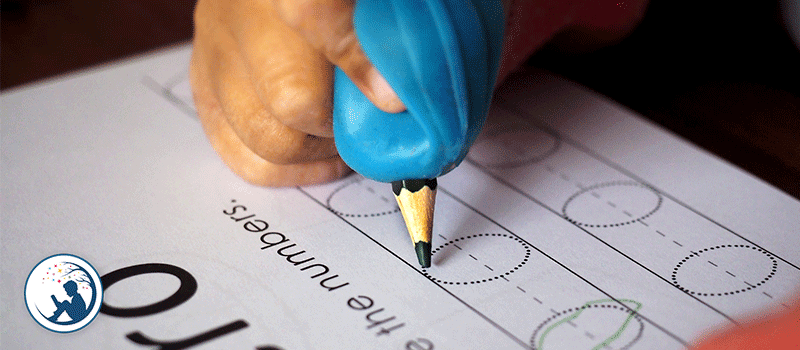Are you struggling to read your child’s handwriting? Perhaps they’re struggling to get to grips (no pun intended) with letter shapes and forming words?
Well, don’t worry! We’ve written this article for the sole purpose of addressing this very common problem and to give you and your little one some top tips and activities to improve their handwriting skills, regardless of what level they’re currently at.
First of all, let me reiterate what I just said: it’s a prevalent problem. After all, handwriting isn’t just about putting a pencil on a piece of paper and making shapes; it’s multi-tasking! The brain tells us what to write and creates the letter shapes, the handshapes the letters on the page, and the eyes focus on the movement and the word – all of which are fundamental fine motor skills that every single child must develop.
Being a parent myself, I know it feels wanting your child to develop quickly and worrying if things don’t seem to be going according to plan. Still, it’s crucial to remember that every single child develops differently – so don’t fret if your four-year-old isn’t a handwriting genius by the time they start school!
It’s typically around the age of six when your child will have the ability to turn their squiggles and scribbles into legible writing.
‘Why six?’, you’re no doubt wondering. Well, this is usually the age when children develop what is known as the ‘dynamic tripod grasp,’ which is the ideal grip for handwriting (improvement).
However, don’t worry if your little one hasn’t quite got the grasp of it by their sixth birthday as changes in the classroom (i.e., greater amounts of time spent on digital learning) can delay this development in some children. Luckily, most homework will take the form of traditional handwriting-based learning, so there’s plenty of time to practice at home!
What Are The Most Common Handwriting Problems Children Face?
If your child is struggling with handwriting, it’s more than likely that they’re experiencing one or more of the followings problems: incorrect pencil grip, insufficient pencil pressure, poor letter/word sizing and/or spacing, poor letter formation, inconsistency where lower and upper case writing is concerned.
Before we delve into the best ways to improve handwriting, it’s essential to understand the role fine motor skills play and why they’re so critical to handwriting development.
What Role Do Fine Motor Skill Play In (Improving) Handwriting?
In layman’s terms, fine motor skills are the coordination of smaller muscles such as those in the hand and eye. Luckily for developing children, fine motor skills can be developed at any time of the day doing pretty much any task – eating food using a spoon or fork, cutting paper with scissors, folding and putting away clothes…basically anything!
Poor handwriting typically stems from lack of fine motor skills development, such as ‘in-hand manipulation’, which is the ability to pick an object up and move it around (which is crucial for letter formation), and ‘visual-motor concerns’, which if not fully developed will result in the ability to identify how much pressure is needed to the writing equipment.
But fine motor skills aren’t just critical to your child’s handwriting skills; they’re also essential for their overall development too.
The Best Activities To Improve Handwriting
#1 – The Correct Grip
Without the correct grip, your child’s handwriting skills will never reach their full potential; therefore, it’s absolutely imperative they practice gripping the pencil every day until they feel 100% comfortable with it in their hand and when writing.
By the time your child enters pre-school, he should already know how to hold a pen or pencil correctly, so showing your little one how to grip a pencil properly is essential. Always be on hand to help correct their grip if need be.
#2 – Does Your Child Need To Relax Their Grip?
Be sure to keep a keen eye on your little ones when they’re writing, looking out for heavy imprints on the page or table below. If the imprints are substantial, i.e., very easily noticed, your child may be applying a little too much pressure when writing, something often caused by stress. Even if your child’s handwriting is neat, apply too much pressure isn’t healthy and, therefore, must be corrected. Help your child relax and show them that they can still write just as beautifully with a softer grip (don’t forget to encourage and praise!).
#3 – Buy The Best Stationery You Can Afford
Ok, so we’re not saying go out and buy gold-plated pens and gold leaf paper, but we are suggesting that you purchase good quality stationery. Why? Because a well-shaped pencil will help your child to hone their grip skills, and a good eraser will get rid of mistakes straight away rather than allowing them to linger and induce stress (who wants to spend ages erasing a mistake?!).
When your child is in the infancy of their handwriting journey, it’s wise to provide them wide-spaced ruled paper (ideally in bright colors!) as this will help them find their feet and gauge letter and word sizing correctly.
#4 – Create The Perfect Environment
A happy, fun, and positive environment is the best place for a child to develop; therefore, when they’re handwriting, ensure that your child is praised, encouraged, and feels excited to do new things.
Given that handwriting is a difficult skill to master, it can quickly become frustrating and disheartening, so always be on hand to give your little one a morale boost when needed. Plus, if you make handwriting time fun, it’s something your child will actively seek out, which will only help them to hone their skills and become one proficient little writer!
However, it’s not just about creating the perfect ‘mental’ environment; a perfect physical environment is required too. For example, a comfortable chair (with back support) that’s the correct height for the table and makes writing feel natural. Bean bags and the like are not advised as these can adversely affect posture, which will, in turn, impact their handwriting.
#5 – Identify Problems
In many cases, children will write illegibly to hide their mistakes, such as grammatical or spelling errors. However, sometimes low self-confidence could also be the cause of writing in this fashion.
In order to correct any issues your child has, it’s imperative to identify what they are. Finding a solution is far better than merely asking your child to keep writing over and over again until they get it right. Masking the issue is never a good idea.
#6 – ‘Patience’ Should Be Your Watchword
Patience plays a huge role in all aspects of development, not least handwriting; therefore, it’s absolutely critical that you are patient at all times (even if it is driving you a little crazy!).
Children have short attention spans and are very easily distracted, particularly if they don’t get something right the first time of asking. Therefore, we, as parents, must do all we can to keep them engaged and motivated – even if things are not going to plan.
To do this, it’s a wise idea to turn handwriting practice into a game or other type of fun activity. You need to provide new stimuli every time you sit down with your child to practice their handwriting; otherwise, they’ll likely get bored, and boredom is never a good thing where learning and development are concerned.
Remember, children often mimic our behavior, so not only should you be upbeat and happy, but you should also show your child how your write, ensuring you do so in a slow and neat manner.
# 7 – Fine Tune Those Motor Skills
For a child to develop both physically and mentally, they should be encouraged to solve puzzles, play games, and do things that challenge their mind and body. This will help them to hone their fine motor skills, which, in turn, will help them to learn how to grip and balance pencil correctly, as well finding the right pressure of pencil on the page, sitting in the correct posture, and improving their overall dexterity and coordination.
Fine tuning their motor skills is really simple as most household chores and activities will help to develop these skills. Anything you can think of that involves the use of their hands and eyes will have a positive impact on their coordination, dexterity, control, and balance. Plus, they’ll be learning completely subconsciously, which is always a bonus! Even playing with toys such a building blocks and lego is useful for this purpose, so don’t put their toys to one; instead, let them indulge!
#8 – Practise Always Makes Perfect!
We consider handwriting to be an art, an opinion something we think everyone else should get on board with! After all, handwriting is a proficiency that can only be fully acquired with a ton of practice.
Sadly, the word ‘practice’ and the word ‘boring’ often go hand-in-hand – but this doesn’t have to be the case at all. There are so many ways you can make handwriting practice fun and enjoyable for your child. With so many handwriting books, games, activities, worksheets, and the like out there, it’s almost impossible for it to be boring!
The Best Strategies To Improve Handwriting: A Summary
At the end of the day, handwriting is one of the most vital skills your child can possess; therefore, it’s understandable to feel concerned if they’re not making the same headway as their siblings or peers. But (and that’s a big ‘but’), children develop at different rates, so rather than worry, your role should be to do everything you can to help speed up their handwriting development. By following the expert tips included in this article, you’ll help to set your child on the right path where their handwriting journey is concerned.

